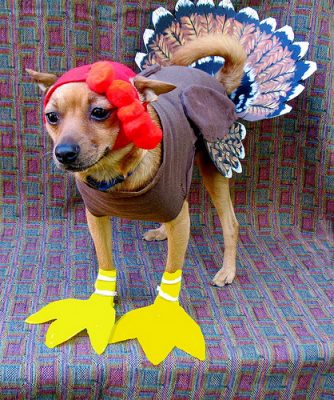
When we came across this sentence, “We conserve wild turkeys by hunting them with special dogs,” our curiosity was piqued. Special dogs?
Thanksgiving is this week, and while we’re cognizant of the fact that not everyone who eats a turkey for Thanksgiving gets their bird from a grocery store, we never knew much about the alternative way to get a turkey, which is to hunt for one’s own gobbler.
Fall turkey hunting with dogs began with the founding of Jamestown, Virginia in 1607, but we also learned that hunting wild turkeys is six times harder in the fall and winter than any other time. This probably explains why less than ten percent are harvested then (leaving ninety percent to be harvested in the spring). Sadly, hundreds of thousands of turkeys are wounded in the spring and never recovered, but such crippling losses are mitigated with the use of a trained dog.
A premier purebred turkey dog that we’ve written about before is the Boykin Spaniel, but more recently, we came across a dog called the Appalachian Turkey Dog which was created by crossing an English pointer, English setter and Plott.
This extremely specialized canine was created by John Byrne (who died in 2012) with a single purpose: To break up flocks of turkeys every fall. The Appalachian got its drive for feathers from from the English Setter. From the Pointer, it got its speed, stamina, and prey drive, while the desire to chase, bark and track was inherited from the Plott.
The job of an Appalachian Turkey Dog is to locate birds, run at them, bark to indicate the flock’s position, then chase down singles and scatter lingering turkeys into the air (barking is key since it allows hunters to find the break site and set up on returning birds that almost always return to the break site). Often, the dogs are fitted with GPS collars since they can roam the woods anywhere from 100 to 500 yards from the hunter. When the dogs encounter turkey scent they follow it to the flock. After the flush, the dog should consent to blind time as the hunter calls the birds back. Concealed in a camouflage bag (a John Byrne innovation) or behind blind material (or both), the ATD waits quietly and calmly as turkeys approach the hunter’s position to finish the hunt.
Despite the fact that the Appalachian Turkey Dog is said to be the second most popular choice of turkey hunters (after the English Setter), it is not recognized by any established registry that we could find beyond the American Wild Turkey Hunting Dog Association which, for all we know, may be a bit like vanity publishing (publishing one’s own book). In doing a bit of research on the Appalachian Turkey Dog, we came across another line (“There’s Bird Dogs, then there’s Turkey Dogs”) that appeared above the photographs of nearly 100 different “turkey dogs” submitted by their proud owners. No two dogs looked alike. So why mention it on a site extolling the virtues of purebred dogs? Because we like our readers to be well informed, and that includes knowing about dogs that sound like a special breed, but may not be.
